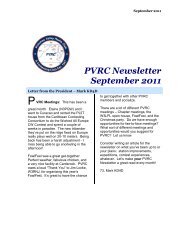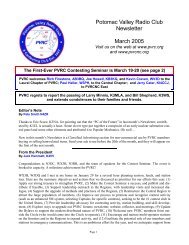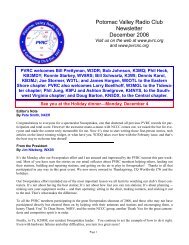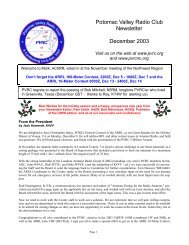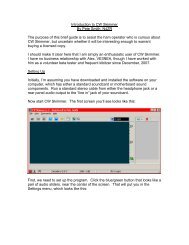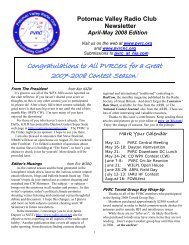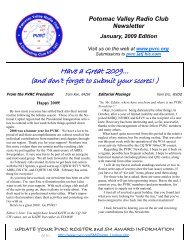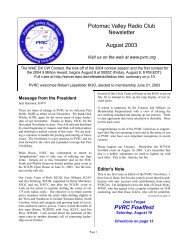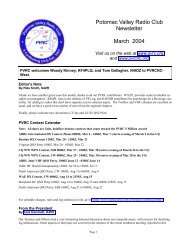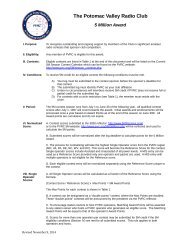PVRC Newsletter October 2003.pub - Potomac Valley Radio Club
PVRC Newsletter October 2003.pub - Potomac Valley Radio Club
PVRC Newsletter October 2003.pub - Potomac Valley Radio Club
Create successful ePaper yourself
Turn your PDF publications into a flip-book with our unique Google optimized e-Paper software.
<strong>Potomac</strong> <strong>Valley</strong> <strong>Radio</strong> <strong>Club</strong><strong>Newsletter</strong><strong>October</strong> 2003Visit us on the web at www.pvrc.organd www.pvrcnc.org<strong>PVRC</strong> welcomes Alex, KE4BUS, Dave, W4DAV, and Bob, K4RG, elected to membershipat the July meeting of the Occoquan <strong>Valley</strong> chapter.The next 5M events are the CQ Worldwide Phone DX Contest, 0000Z, Oct 25 - 2400Z,Oct 26, and the ARRL CW Sweepstakes, 2100Z, Nov 1 - 0300Z, Nov 3<strong>PVRC</strong> regrets the passing of "Bill" McGeehan, K3HCE, and Jim Murray, W4TKREditor's NoteExcept for a few human failings (notably, my error in not mailing to one group of addressees until mid-month), the firstelectronic distribution seems to have gone reasonably well. It was predictable that a few e-mail addresses out of the 580-odd would turn out to be erroneous, so if you know anyone who was expecting an e-mail newsletter and didn't get one,have them contact me. My e-mail address is n4zr@contesting.com.I'm still looking for contributors. Always will be, I expect. If you have something to say that is germane to amateur radiocontesting, don't be shy about sending it to me. I'll help you with technical issues like illustrations and formatting so thatit'll look great. Have a favorite operating trick you'd like to share? A piece of software that you've found useful? An antennadesign that works well for you? Tell people about it!!!!From the Presidentby Jack Hammett, K4VVThe shift of the circle was briefed and discussed in both the Central meeting at Temple Hills on 9/8/03 and at the NWmeeting in Frederick on 9/16/03. The change in the circle was approved in both meetings, which together compose the"original Central meeting" empowered for decisions in the current Bylaws. So the action is done. We do need to relookour Bylaws for both decision and membership requirements to modernize and fit our current distributed structure.Thanks to the Circle Committee for this important action-KE3Q, Rich, K2AV, Guy and WX3B, Jim, supported by N3OC,Brian, and K4VV, Jack. The present location of the circle center is near Louisa, Virginia. The committee recommendedchanging the center to a point 5 miles WSW of the junction of US 64 and Virginia Route 15; this junction is about 15miles east of Charlottesville and roughly 11 miles west of Louisa. Moving the center location about 16 miles WSW ofLouisa will allow a 17 member active contest team in Winston-Salem and High Point, NC to be included in the <strong>PVRC</strong>circle. The committee has found no impact on <strong>PVRC</strong> contesters who live in the circle now.The impact of the shift is to include a band of dense population around Winston-Salem, NC to grow our contesting membershipinto another major community. The shift pulls the circle tight along the Maryland Coastline, minimizing "oceancoverage," and touches Charleston, WV to encourage membership.Many of our members have had major storm damage in September, giving us a handicap and some necessary rebuildingas we go into the primary contest season. It is remarkable how neighbors are helping one another in these difficult times.Page 1
Cain's book is well-organized and well-written, interlacing the stories of the Colvins with the exploits of Weil and his successionof Yasme craft. Reading about Weil's ventures, one appreciates how different and how challenging working DXin the fifties and sixties was from today, and how much the DXCC program has evolved. The business of obtaining a hamlicense from most foreign jurisdictions was either impossible or very complex - in fact, the United States had no reciprocallicensing arrangements with any country except Canada until the 70s, making it difficult to secure permission to operate inmany areas where obtaining a license today is a given. Equipment was massive and power requirements were challenging.Despite these obstacles, the Colvins, acting as unofficial ambassadors representing ham radio, were often able to succeedin fielding operations from locales where other DXpeditioners had been unsuccessful. Much of their hard work, gentleassertiveness, thoughtful diplomacy and good will form the basis for the good relations ham radio enjoys in manycountries today.K1TN has succeeded is compiling both a meticulous history and a highly readable story, which will resonate with manyhams who either remember or grew up hearing stories of these three DXers. Even for the newest additions to our hobby,the story of early postwar DXpeditioning - an era before computer logging, before packet clusters, before e-mail, beforereciprocal licensing - should be fascinating. The book includes many pictures, maps, and statistics. It is certain to take itsplace in many ham libraries as another important contribution to the history of ham radio.<strong>PVRC</strong> SpotlightBy Jim Nitzberg, WX3BDavid Collingham, K3LPMany of you already know David Collingham, K3LP. David wasnice enough to provide an excellent biography based upon my favoritequestions. Hopefully, <strong>PVRC</strong> members will be viewing moredetails on David’s (to be completed) web site.How did you first get interested in Ham <strong>Radio</strong>?I first got interested in radio communications and electronics workingwith my Grandpa Boo (Raymond Charles Collingham), at the age of 9,at his radio communications and TV repair business in Baldwin Park, California.In 1973, a new high school friend of mine, Steven Cook (ex. WC6IFG, now WG7K), had his ticket and introduced me toAmateur <strong>Radio</strong>. At the time, Mr. Louis P. Malory (WA6DVK) was head of the Fontana High School English Departmentand also set up an Electronics and Communications program for high school students.I enrolled in the Electronics and Communications program in 1975. The students in the group set-up the new low powercommercial broadcast and amateur radio stations at the high school and were responsible for maintenance. We also studiedelectronics theory, and prepared for amateur and broadcast license tests.Who was your Elmer?Louis Paul Malory (WA6DVK) was my Elmer. He was responsible for taking the time to teach me Morse code and thetechnical information needed to pass my Novice Class license (WN6KTF) and Third Class <strong>Radio</strong>telephone Licenses inApril 1975.What set you over the edge?After seeing my friend Steven Cook's new Drake C Line, in 1974, the blue tinted meter displays and the glowing filamentsin the Drake L4-B amp were impressive and are vividly planted in my memory.Where did you first operate from and what was your equipment?In April of 1975, I received by Novice Class Amateur <strong>Radio</strong> License, WN6KTF, at the age of 16 while attending the 11 thPage 5
grade in high school. While living at my parent's home in Fontana, California, my high school friend, Steve Cook and Iconverted an old chicken hut into my radio room. I would often spend all night operating, six and seven days a week,sometimes using a flashlight so my parents won't know I was still up on school nights. I would be lying if I said I neversaw the sun come up on school days without sleeping. I was an excellent student and missed very little school. After all,we had an Amateur <strong>Radio</strong> Station, WB6HJJ, at the Fontana High School thanks to our Elmer, Louis Mallory (WA6DVK).I remember always reading the old QST magazines and often dreamed about having the ultimate contest or DX station.The chicken hut, with a tin roof, cement floors and no insulation, would get real cold during the winter and very hot duringthe summer months on the desert, but nothing distracted me from operating the radio. As a kid, that chicken hut radioroom was the greatest. My parents purchase me a new TS-520 from Henry <strong>Radio</strong> in Anaheim and I had installed InvertedVee's and a home brew 2 element 10 meter beam I made using an old QST magazine article.After graduating from Fontana High School in 1976 with my General Class License (WB6KTF), I headed to DeVry Instituteof Technology in Phoenix, Arizona. Before graduation, I passed my Advanced and Extra (AA6DC) Amateur <strong>Radio</strong>Class Licenses, and FCC Commercial 1 st Class <strong>Radio</strong>telephone Broadcast License.Like many others, this is when responsibility stepped in and took ownership of my life. I got a career and good payingjob, got married and had a few children (five to be exact), strapped myself with a new mortgage and car payment, and repeatedit at least five more times as I advanced in my career. The next thing I knew, I was working as much overtime aspossible, barely making payments and only operating contests when I could fit it in my schedule. The 1980's left little operatingtime for me.Where Do You Live Now?In November 1999, my wife Rebecca and I purchased a 25 acre lot about 5 miles from our last QTH in Mt. Airy, Maryland.The lot is absolutely wonderful; elevated with great views.Do you have any comments about your operating time at W3LPL?I have had the pleasure of operating from W3LPL during the ARRL and CQWW DX CW contests on several occasions.The operating style and team experience was interesting and of great value. Frank’s regular operators work very hard tokeep the W3LPL image respectable and record competitive. To operate for W3LPL is rewarding and very focused. I appreciatethe opportunities and look forward to working from W3LPL in the future as needed.Any other contest stations you care to comment on?Over the years, I operated from W3GNQ's QTH for ARRL and CQWW CW and SSB contest. Operating from Dick'sQTH was always fun.What DX-peditions have you been on?I operated as P40DC, J6/K3LP, J6R (3x), A61AF (2x), A61AJ (3 x), VP5LP, PJ7/K3LP (2x), AA6DC/GM4, M0/K3LP,LA9HW, 5H3LP, and A4/K3LP.What Contest DX-peditions have you organized that involved more than one person?- A61AJ in November 1997 CQWW DX CW, Multi-Multi, K3LP (leader) and KE3Q operators- J6R in <strong>October</strong> 1999, Multi-Multi, CQWW DX SSB, K3LP (leader), N3NT, K3UG, J69AZ and K7KL)- J6R in March 2001, Multi-Single, CQWW SSB, K3LP (leader) and J69AZ operators.- VP5LP in February 2003, Multi-Two, ARRL DX CW, K3LP (leader), WX3B, N7DD and N3SB. We took 1 st PlaceWorld.What were your most exciting DX-peditions?My most exciting DX trip was when I operated from the Dubai Men's College (A61AF) in June 1996. At this time, CWfrom this region was rare. I arrived at the station on a Friday afternoon and was given authorization to operate for the day.I didn't want to leave the college, thinking the guards would not allow me to return over the weekend without additionalauthorization, so I slept on the radio room floor using my jacket as a blanket until the following Monday. I made almostPage 6
3,000 QSO's using a hand key and ate from the schools vending machines. I remember my fingers being numb for daysafter the trip [if you need an A61AF QSL card, Dave still has the logs and QSL cards at his home - WX3B].In November 1996, I operated from A61AJ's, Ali's personal home QTH for a week and also entered the CQWW DX CWcontest as Single Operator, HP, Un-Assisted with the A61AJ call sign. During this visit, Ali and I planned my return tripin November 1997 to construct a multi-tower and antenna contest station at his farm location just outside the Dubai citylimits. When I returned to Maryland, I worked with Norm (W3NRS) and Joel (RF Connection) to assist in quoting Rohn45G towers and preparing cabling other tower materials for shipment. Ali decided to have the towers homebrewed about 2weeks before arrival. W3NRS and I sent Ali a set of Rohn 45G Tower drawings for fabrication and foundation installationinstructions. I had ordered KLM’s 3 element 40 meter and 6 element 10, 15 and 20 meter mono-band antennas andshipped them direct to Dubai for installation in November.For my November 1997 trip, Rich Boyd, KE3Q assisted with antenna assembly and installation work. The remaining onsitework was basic contester knowledge and some quick fixes to the tower foundation and anchors that didn’t complywith plans sent in advance. We entered the CQWW DX CW contest as a multi-multi entry since there was no Multi-Twocategory at the time. W3UR (Bernie) was kind enough to accept the QSL Manager duties for all my A6 and A4 trips.Thank you very much, Bernie.I returned to A61AJ in March 1998. At this time, I assembled two additional KLM 6 element mono-band antennas andincreased the 20 meter tower from 100’ to 150’ with local helpers. The 6 element mono-banners were installed at 50’,100’ and 150’ levels using the WX0B Stack-match box. In addition, assembled the KLM 2 element 80 meter beam andinstalled it on a new 100’ tower.I operated the CQWW WPX in 1997 using A61AJ call making 3, 984 QSOs as a Single Operator.What is your favorite contest? Why?I enjoy the CQWW DX CW contest the most. I prefer CW over SSB, but feel I am effective at both.Working CW reminds me of early morning fishing. As the sun comes up, you never know what you’re going to catch.What's planned for the next 6 months?On November 14, 2003, Clint (W3ARS) and I will go to the French side of the island, St. Martin and will be installingtwo beams and a bunch of wire antennas. During this 10 day visit, we’ll operate as FS/K3LP and FS/W3ARS. The equipmentwill be operated during the CQWW DX CW contest as FS5UQ.The exciting news is that Rebecca (my wife) and I are going to have a new son at the end of November 2003.The VP5LP team with two additional members has scheduled to activate FS5 for the ARRL DX CW 2004.What was your most Exciting and Rewarding Contest?After spending lots of money over the years going on DX-peditions, the ARRL announcement that our VP5LP contestteam took 1 st Place World in the ARRL DX CW contest, category Multi 2, in February 2003 was icing on the cake. Webeat our nearest competitor by 1 million points and beat all DX multi-multi stations, thus having the largest DX stationscore. The team included K3LP (leader), WX3B (Jim), N3SB (Steve), and N7DD (Larry). This team was professional andfocused.We came about 13 QSOs short of the North American record set by 6D2A. We could have accomplished this easily if wehad not lost a network card in the laptop on the second day. This caused a half-hour off the air.Any Final Comments?I’ve been a ham for over 25 years now, and have met friends all over the world. I enjoy my many friendships with <strong>PVRC</strong>and K3PZN members. K3UG (Barry), A45ZN (Tony), WX3B (Jim), NY3A (Steve), N3SB (Steve), and AK3Z (John) arethe guys I most frequently exchange technical information with and maintain interest in the hobby. I want to thank themfor their ongoing commitment and friendship.Page 7
VHF and Above <strong>Radio</strong> FrequenciesBy Chuck Watts, W4XPOnce thought of as useless, now one of the most sought after resources in the world … use them orlose them!Roving with K8ISK on our way home from Ohio wasn’t very productive. If someone asked me what the activity waslike, I’d have to say “pretty dismal.” Like so many of the other VHF and above contests, except the Cumulative 10 GHzcontest, the September VHF QSO Party has experienced a steady decline in participation.In his April 2003 QST World above 50 MHz Column, Gene Zimmerman, W3ZZ, discussed at length the fact that therehas been a steady decline in log submissions for VHF contests. This can loosely be equated to a reduction in the numberof stations, not necessarily operators, participating in VHF and above contests. I won’t recapitulate the content of Gene’sarticle here, but it is worth reading or rereading to get a better perspective on the state of VHF contesting in general.When the ARRL no longer printed Sprint scores in QST, and then NCJ, and subsequently ceased altogether to sponsor theSprints, these events nearly passed out of existence until two years ago when the Southeast VHF Society assumed thesponsorship. Since the SVHFS has been collecting and compiling scores, Fall and Spring Sprints have experienced asteady increase in participation. It is too early to tell, but based on some of the postings I’ve read on the Internet, relatedto activity in the 144 MHz Sprint held on September 22 nd , it appears that this years participation is suffering the same fateas the “big” VHF contests; a significant decline in participation.I have to admit that I didn’t participate in this years 144 MHz Sprint. But I did have, as many of the readers of this columnhad, some rather obvious extenuating circumstances known as hurricane Isabel! Downed antennas, flooded basements,and worst of all, no commercially available power! If your main AC is restored, and you have the station capability,we all need to participate, even if it’s just for a portion of the contest period, to show that we are contesters and wesupport the SVHFS’ efforts to keep the VHF and above Sprints alive.The rules for all of the band sprints are the same and are available at: http://www.svhfs.org/fall_sprint_rules.htm. Put thedates for next year’s Sprints on your calendar! It’s too late for the 2-meter Sprint, and possible the 222-MHz Sprint, buthere are the times for the remaining bands, including 222 MHz:222 MHz Fall Sprint - Sep 30 (Tuesday) - 7 PM to 11 PM local time432 MHz Fall Sprint - Oct 8 - 7 PM to 11 PM local timeMicrowave (902 MHz and above) Fall Sprint - <strong>October</strong> 18 - 6 AM to 1 PM local time (Choose any 5 hours, in one hourincrements)50 MHz Fall Sprint - 2300Z Oct 25 - 0300Z Oct 26Exchange: Call sign and 2x1 degree grid-square locator. Signal report optional; QSO Points are 1 pt/QSO. Total score:QSO points x grid squares. For rovers, count grid squares separately from each new grid square activated and submitseparate logs from each grid square. Logs due 4 weeks from the end of the contest in ARRL VHF contest format.144 MHz Sprint logs to: Ottmar Fiebel, W4WSR, PO Box 957, Hayesville, NC 28904 or to ottf@webworkz.com222 MHz Sprint logs to: Bob Lear K4SZ, PO Box 1269, Dahlonega, GA 30533 or to k4sz@arrl.net432 MHz Sprint logs to: Jim Worsham W4KXY, 1915 Oak Wind Lane, Buford, GA 30519-6766 or to w4kxy@arrl.netMicrowave Sprint logs to: Greg Robinson KB4NVD, 208 Dogwood Acres Rd, Hampton, TN 37658-3348 or toRover@wireco.net50 MHz Sprint logs to: Ray Rector WA4NJP, 3493 Holly Springs Rd, Gillsville, GA 30534 or to wa4njp@bellsouth.netThe next “big” VHF and above event is the ARRL January VHF Sweepstake. January is of course the month of SuperBowl, cold temperatures, and sometimes really bad weather! Next month I’ll touch on some things to expect in the JanuaryVHF SS, not only participation wise, but propagation (or lack thereof!) too.If you have suggestions or comments, please contact me at w4xp@arrl.net or send me a message via the DXCluster.Page 8
The ToolboxBy Don Daso, K4ZAA few e-mails have trickled in, indicating that rivets are not well-liked, nor considered suitable for antenna/tower work.So, we continue our “treatise on fasteners” this month.Ever been to France—to Paris? Notice that tower? Gustave Eiffel, an engineer who founded a metal-works company,decided a 300 meter tower should showcase the 1889 Universal Exposition in Paris. Construction began in July of 1887,and 22 months later, was completed. The tower sections were built at the Eiffel factory on the outskirts of Paris, boltedtogether, taken to the job site, hoisted up (using steam cranes, which were themselves then hoisted higher as sections ofthe tower went up), and then riveted together. Tolerances were extremely close, even by today’s standards, for somethingof this size. There are over 2.5M rivets in the tower.I can hear the arguments already. “That’s great, Rundy, but steam power and rivet throwing are pretty much archaic skillstoday.” Granted, but the point is that loose rivets still offer advantages to anyone assembling metal surfaces, such as simplicity,speed, and low cost. That’s why you see them used so much (if you simply look). Rivets are ideal for flexiblejoints. Rivets work very well in tightly joined (mating) parts. Rivets are ideal where repetitiveness (pivoting) joints arerequired.The point is, obviously, that rivets are okay to use. I have used them successfully for years. They are especially useful insmaller (say VHF) antenna projects. Don’t rule them out because of rumors you’ve heard on the air or read about on theInternet. Don’t believe all the horror stories from folks who haven’t learned how to use tools the right way. Get a copy ofCarroll Smith’s Nuts, Bolts, Fasteners and Plumbing Handbook, Motorbooks International, 1990 (ISBN 0-87938-406-9).Learn and enjoy.Next, on to stainless steel, the proper use of which is a perennial source of frustration, confusion, arguments, and so on,among antenna and tower-building hams.What we term “stainless steel” really comes in around 60 varieties, or grades, of metals. All are essentially low carbonsteel, which contains chromium at 10% or more by weight. The chromium is what gives the metal its corrosionresistant properties.Arguments almost always arise about whether or not stainless steel is magnetic. The correct answer, that, “No, it’s not,”and “Yes, it is,” certainly doesn’t help. Here’s the truth (right off the Stainless Steel Information Center’s webpage):There are several “types” of stainless steel. The 300 series (which contains nickel) is NOT magnetic. The 400 series(which just contain chromium and no nickel) ARE magnetic. So, walking around with a magnet will not make you an“expert” on stainless. But, reading the information on the SSINA website will get you closer, if that’s what you want.And let’s check the website and get that “A-word” definition out of the way right here (used and spelled correctly):Austenitic stainless steel, which is the name given to a structure that has high ductility and consists of both chromium(15 to 30%) and nickel (6 to 20%). The original designation for this type of structure is the 300 series, sometimescalled 18-8 or 18% chromium and 8% nickel, of which 304 and 316 are the major grades.Arguments (or at least heated debates) also usually follow from those who believe stainless steel fasteners are “too weak”or brittle to use in ham tower/antenna projects. Again, a few minutes reading Carroll Smith’s book will show you theproper ways in which to use bolts. And you will see that if you don’t like rust running down the legs of your tower, thenusing stainless hardware does not mean you’ll find your beam on the lawn some morning. If you live in a corrosive environment(say the Caribbean), it’s the only answer. (I was amazed to see corrosive action taking place within two weekstime on St. Martin back in 1998, for instance!)If you’re still not convinced there are applications where stainless can and/or will make your life easier, you can simplycheck the library or the World Wide Web for further reference sources. Big industrial suppliers will often have pages oftechnical information available on their websites (thinking that if they can influence engineers, they’ll buy, etc.), or linkswhich contain such information. For instance, check out Marine Fasteners, Inc. as a typical example: http://www.marfas.com/products.shtmlPage 9
I’ve purchased stainless hardware from TEK SUPPLY for years, and never had a problem. Their service and prices (thehardware is probably Chinese in origin) are hard to beat. But their on-line catalog isn’t that great; get the old standbypaper version. This farm supply company also stocks a variety of things the modern tower and antenna builder will finduseful, like rope, cable ties, turnbuckles, thimbles, electrical supplies, and so forth.Using stainless requires some modification to your work methods. If you’re used to spinning nuts on, or using powertools, in a word, stop. The faster “speeds” will cause the stainless to “gall” or seize. Basically, as the two surfaces runtogether, they will heat treat themselves, and pieces of the top layer will be deposited on to the bottom layer, causing theseizure. The simple solution is to use “anti-seize” compound, or some other lubricant, and install the fasteners slowly. (Icarry a tube of Teflon grease in my tool pouch. It’s small, slippery, simple to use, and doesn’t stain like some otherlubes.)Keep the questions, suggestions, and comments coming. What’s in your toolbox?Why RTTY Contesting?By Mike, K4GMHPete, N4ZR, (<strong>Newsletter</strong> Editor) asked me to write a bit on RTTY contesting. A couple of suggested topics were the joysof (if any?) and/or the how-to-do-it (if different than other modes) for RTTY contesting. Addressing the “how-to-do-it”should cover both. Maybe you have been thinking of trying RTTY contesting. Hopefully, the following will help youdecide it is worth the effort.In my view, RTTY contesting has a lot in common with other modes (SSB/CW) of HF contesting. You have HF propagationto contend with, submit logs, competition, etc. Some differences (major/minor?) you will find in RTTY contesting isthe reduced pace (QSOs per hour) over the length of a contest, fewer participants, some of the rules are different thanother modes for the same sponsored contest, 100 percent transmitter duty cycle instead of 20-30 percent for other modes,additional software and hardware required to participate, and different receiver tuning technique.Examples of the differences are:• Pace -- 40 or 50 per hour QSO rate over the length of a major contest, e.g., RTTY Roundup, CQ WW RTTY, shouldput you in the top ten. A hundred plus QSO rate for ten minutes is possible if you have a good station for the contest.The fast (truncated) response between stations isn’t a norm in a RTTY contest. Still, it seems that after each majorRTTY contest, the RTTY Reflector will have at least one epistle on why and how the exchange between stations canbe sped up. The nature of RTTY has a certain amount of control over the pace as the sending and receiving speed isthe same between the most experienced RTTY contester and the newbie – 45.45 baud (60 wpm). This pace limiterforces all to realize that RTTY contesting is not about how fast one can speak or send his exchange. The ability totype rapidly and accurate is at the same level as needed for SSB/CW contesting. The transmitting portion of yourRTTY contesting is similar to the way you provide information in other mode contesting as most of the transmittingis done by function key initiated macros. New hams to the RTTY mode seem less intimidated and readily join the funof RTTY contesting. Also, the experienced RTTY contester realizes that if he takes a few minutes, during a contest,to help the newcomer he won’t fall behind his competitors since they are limited by the same 45.45 baud exchangespeed.• Number of participants -- any RTTY contest has no more than half as many participants as a major ARRL SSB/CWcontest. Fortunately, the number of logs per RTTY contest is increasing. The World RTTY Contest Scene web page,http://www.rtty-contest-scene.com/index1.html, has a graph showing an increase each year over the last three years inthe number of submitted logs for the 17 yearly RTTY contests. Still, one major ARRL contest like SS will have asmany logs as all 17 yearly RTTY contests.• Rule differences -- one contest with a major difference between SSB/CW and RTTY is the WAEDC. In the RTTYversion of this Contest there are no continental limits – everybody can work everybody. QTCs must be sent betweendifferent continents, but every station can send and receive QTCs. However, only a sum of ten QTCs can be sent orreceived between two stations. The SSB/CW sections of the WAEDC allows QSOs only between European andnon-European stations. Also, QTCs can only be sent to European stations.• One hundred percent duty cycle for the transmitter/amplifier -- welcome to RTTY. SSB/CW duty cycle is between20 and 30 percent. If your transmitter/amplifier or antenna system can’t tolerate the higher duty cycle, then consideroperating in the lower power category. Just about all the RTTY contests have LP category. RTTY contesting willfind any weak spots in your transmitting system.• Additional hardware/software -- this is assuming you already have a radio/computer connection. If you are doingPage 10
SSB contest using the computer to send "DVP files," then the only additional hardware may be another cable betweenthe radio’s audio output and the computer’s sound card line input. The computer can then decode the received RTTYsignal. The sound card generates the mark/space tones and sends them to the radio over the same audio cables usedfor SSB contesting. If you are using Writelog, you already have S/W capable of decoding .the received RTTY andgenerating the mark/space tones. However you will have to become familiar with the operation of this WL feature.• Receiver tuning technique -- the computer has to “hear” the mark/space tones to decode RTTY. This is differentfrom SSB/CW as you determine when you have the signal tuned in by your ability to copy the information. WithRTTY, the computer decodes and turns the mark/space tones into meaningful information. You have to properly tunein the RTTY signal so the computer can do the decoding. Fortunately, the RTTY S/W provides a tuning indicatorallowing you to place the received mark/space tones within the usable decoding range of the computer. Yes, youcould operate a RTTY contest without hearing any of the received signals. However, you’ll find as your ability improvesto distinguish the audio of a proper tuned in RTTY signal, the easier it is to be get the signal into the acceptabledecoding range of the computer. With practice, using both audio and the computer generated tuning indicatorallows one to rapidly tune in a RTTY signal for proper decoding.So that's a snapshot of some obvious differences between SSB/CW and RTTY contesting. “Why do I like RTTY contesting”is a question that kept creeping into my mind as the above was written. Some of you are SSB-only contesters, othersare CW-only, others concentrate on VHF and then there are those folks that like to do them all. “Why” has to be answeredby each operator. In my case, pinned down to give an answer, the above paragraphs are why I like RTTY contesting.[editor's note -- Mike is one of the leading RTTY contesters in the country, and I'd like to get him to tell us more, for examplean article giving specific recommendations on how to get started in RTTY contesting. If you think that's a goodidea, drop him, or me, a note.]Around the <strong>Club</strong>Meeting minutes from the regionsNorthwest Region September 2003 by Bud Governale, W3LLThe NW Region met at the City Buffet in Frederick, MD on 16 September. In attendance were K2PLF, W3KHZ, W4AU,K4VV, W0YR, NE3H, K3WC, N3II, N3UM, N3VOP, K3ZO, W3ZZ, N3YDT, W3EKT, W6NRJ and W3LL.A lot of good informal discussion took place both before and after the meeting.K3ZO, Fred expressed condolences for K3HCE who was fatally injured by a drunk driver while crossing the street afterattending an Orioles game.K4VV, Jack provided an update on the <strong>PVRC</strong> circle discussion and the conclusion reached by the circle committee--KE3Q, Rich, K2AV, Guy and WX3B, Jim, supported by N3OC, Brian, and K4VV, Jack. [details are in K4VV's report -ed.] A motion was made by Jack, K4VV to relocate the circle center as described. The motion was seconded by Mike,W0YR and passed unanimously.W3ZZ, Gene reminded everyone about the 30 minute minimum off time requirement for the Sweepstakes and otherARRL contests.W0YR, Mike circulated a get well card for K6IR, Ken Miller.From around the table ...K2PLF, Marty worked the VHF contest from W3SO. He noted that countries which eliminated the morse code requirementhad good participation in the WAE contest.W3KHZ, Art did not work the VHF contest because his gear is still packed up from his Canada trip. He did make QSO'swith many of the Route 66 special event stations. Art is planning to install two more towers to accommodate 6m and 2mbeams.W4AU - This was John's first meeting. His main interest is CW contesting, especially the sprint contests. John bought anPage 11
Orion 4 days ago and likes it a lot.K4VV, Jack is working on fixing up his Super- and Big-Bertha towers. He is working to have one of them ready by November.He worked the VHF contest at W3SO along with ten other operators. Jack gave well deserved kudos to N4ZR,Pete for an outstanding September newsletter. Everyone agreed. Jack also noted those <strong>PVRC</strong>ers who produced top scoresreported in various publications. He also commended W0YR, Mike and N3JT, Jim for their leadership and hard work towrite and distribute the <strong>PVRC</strong> FCC submission on the BPL issue.W0YR, Mike noted that the "codeless contesters" were good and wondered where they got their training. He is gettingready to put up an 80M antenna.NE3H, Joe had no comments.K3WC, Dusty's towers are still on the ground.W6NRJ, Jim has been away from our NW meetings for the last 5 months. He discussed three points 1. Get on 12M orloose it like 11M. 2. Shawn Hannaday is donating $5K (or more?) to a Retired Marine who is restricted by deed covenantsfrom putting up a flagpole (could be a stealth antenna?). 3. If BPL is permitted, 6M and HF will be unusable. Japan gaveup on BPL because of strenuous HAM objections. Jim congratulated Fred, W3ZO, for his outstanding contesting article inthe September <strong>PVRC</strong> newsletter.N3II, Dave, noted that NTIA, which represents the Pentagon views in the BPL issue, does not want it. Dave will be takinghis 29' fifth wheel trailer to FLA in January. He noted good conditions during the VHF contest.N3UM, Ben, purchased an Orion in June and also likes it a lot. He tried it during the IARU contest with W3LPL andK3ZO on either side of his frequency - the brick wall filters did a good job in keeping the frequency useable. He found the60M band boring. During an Alaska vacation, he lost some elements on his beam from a falling tree limb and had it repaired.Ben switched from CT to Writelog which he used in the VHF contest.N3VOP, Mike passed around an X rated nudist colony QSL card received for a QSO with AG1RL. The card generated alot of interest. Mike asked why there were two <strong>PVRC</strong> 5M contests (WAE & VHF) during the same weekend. The responsewas it's a coincidence which happens once every 10 years. It was noted the ARRL June VHF contest does notpresently count as a club competition event. The Carroll County club had a bike tour in Thurmont on Saturday which preventedMike's participation in the VHF contest except for Sunday.K3ZO, Fred was delighted with his stay at Marty's (K2PLF) Hawaii QTH during his ARRL trip. He participated in the AllAsia contest, noting good 15M conditions. Fred also participated in the VHF contest last weekend. The contest producedno 6M E skip. There was some scatter on Sunday morning.W3ZZ, Gene noted it was a good VHF summer, producing the best 2M E skip in history. Europe had about 30 openings.In the US, there was a big 220 MHz E skip opening. September produced several tropo openings including a recordbreaker. Gene noted that tomorrow night should produce some tropo openings thanks to hurricane Isabel. He participatedin the VHF contest. Gene's towers are in need of reguying. His 80M antenna fell down and his 40M antenna has beendown for some time. He plans to put up an 85 foot combination 160M & 80M 1/4 wave sloper.N3YDT, Jim has been off the air the last 3 months. He has 104 countries confirmed on 6M.W3EKT, Ed added 5 new grids during 2M tropo openings and made 100 QSO's in the VHF contest. He does not plan totake down his rocket launcher supported antennas because of hurricane Isabel. Ed now has slight improvement in his vision.He is using Writelog to blow up text.W3LL, Bud attended Fallfest and worked the WAE contest. Bud announced his retirement from Black and Decker lastweek after 33 years with the company.The meeting was adjourned at 8:30 PM and followed by a continuation of informal discussions.Southwest Virginia Chapter The SW Virginia Chapter <strong>PVRC</strong> held its first meeting of the season Friday, September5th. In riotous attendance were Mike - N4GU, Anthony - WM3T, John - W4MAN, Susanne - W0MAN, and DavidPage 12
N4JED. Additional words were sent by K1GG, K4IQ, W4YE and K1SO (more on that later). Our regular waitress Kimhas returned and kept us well fed and barely under control.First off, the chapter sends their best wishes to Buddy-W4YE and his father and family. Buddy's step mother passed awaythis past week, and Buddy was down south with his father. His presence and guidance were missed by all present.John and Susanne are keeping busy on the air now that antennas are up and working, though the bands have not been encouraging.David was the only one present to work the WAE contest, and then just briefly between storms. He has finally submittedhis paperwork for CW DXCC and awaits to hear back.Anthony has set up his own domain and server system. He is busy relocating several ham radio club web sites and thechapter's reflector to it. Discussions were entered about connecting thru his site on the web to the <strong>PVRC</strong> cluster and reestablishingan on-air DX cluster in SW Virginia. We tabled further discussions until we could get K1GG's input.Anthony has recently updated the Chapter's in-chapter 5-mil contest standings. Buddy took a further leap to the lead withhis recent contest showings, leaving David a more distant second. Watch for more serious attempts to catch up from thelow power station. Be sure to check out the scores at the bottom of the <strong>PVRC</strong> web site score page.Additional subjects ranged from best bands per contest for rates to antenna options for portable operations. Everyone presentdiscussed their Field Day attendance and four different VA clubs benefited from a <strong>PVRC</strong> presence. It was noted thatthe proposed Russian DX Contest for the <strong>PVRC</strong> 5-mil award fell on the VA QSO Party weekend. Most of our membersparticipate mobile in the QSO party and possible the same for other chapters. So there may be some conflict in operatingif this event is added. We hope that further consideration is given to this.Having finished up his thesis, Southwest Virginia Chapter Regional Coordinator Mike Barts - N4GU is looking to moveout of the region and has decided to pass on the reins of the position. In a surprise vote, following much behind the scenestelephoning, David - N4JED was coerced into accepting the position by a unanimous count. Mike, having about finishedhis time at VA Tech, is busy searching the real world for employment. Several prospects could keep him within the clubcircle while others are in cooler climes.We do express our thanks to Mike for his fine leadership and wish him well with his move from the college environmentto the real world . He is working hard to stay within the <strong>PVRC</strong> circle and we hope to see his scores continue to beadded to ours.Notes were taken of the behind-the-scenes plotting (K1GG, K4IQ, etc) and a Secretary will be selected at the followingmeeting. Everyone is invited to be in attendance to protect themselves.The after-the-meeting parking lot gathering was attended by all (actually due to the fine weather, several groups were outsideafter dinner). Discussions ranged from advantages of JT44 communications to a possible EME special event. Othertales too good to put in print were also heard. You should have been there.The next meeting of the Southwest Virginia Chapter <strong>PVRC</strong> will be Friday, <strong>October</strong> 3rd, 6pm at the Roanoker Restaurant,Roanoke, VA. Let's try and have a better turnout. And mark your calendars for the next couple meetings, November 7th.and December 12th. See you there.The Laurel Region held a short quarterly meeting in conjunction with the LARC monthly meeting on Sept 14. The clubwants to make a significant effort in the CQ WW DX SSB in <strong>October</strong>, and the SSB SS in November. That means weneed some significant antenna work and several work parties were scheduled. We lost our 75-40 meter dipoles (know oneknows when or how), and the 2/440 colinear got fried in a lightning storm this summer. Attending the meeting wereW3YD, W3DAD, N3TZA, WV3D, KB3BWR, N3JMK, K3HDM and KB3EQH.Don't Miss CQWW SSB -- Beginning at 0000Z <strong>October</strong> 25Page 13
This Just In … Look for 4X/KC8FS in CQWW PhoneHal, KC8FS, advises he will be in 4X this month, and plans to be on the air there for CQWW SSB. He says, "I will likelybe operating from the IARC <strong>Club</strong> Station in Raioot but am working on another possibility. Am trying to nail down someof the details coinciding with my scheduled travel arrangements but do intend to make some noise on the bands from 4Xand especially will be looking to give out multipliers to the <strong>PVRC</strong> gang."Hal promises to update specifics [presumably via the <strong>PVRC</strong> reflector] as his plans firm up.Weather WoesBy the EditorDick, K3DI, suggested that we might run pictures of damage from HurricaneIsabel. Dick generously contributed pictures of his tower casualty(see the photo at right), which resulted when an 84' tree fell on the guys ofhis 100' Rohn 45 tower, bringing his C-31XR and the top 50 feet crashingdown. There are some things that you can't design against, no matter howcareful you are!Some other club members also suffered major damage. K4JA's 40-meterrotating tower apparently twisted till it broke, bringing down his stackedK3LR yagis and 178 feet of AB-105. I commented to Paul that at least itproved the strength of his worm-drive tower rotators, since the tower failedbefore the worm drive did. Small consolation! However, at press timePaul was well into salvage and reconstruction. Photos are below.Others, fortunately, took major defensive steps before the storm and didrelatively well. Howie, N4AF, who lost virtually everything in anotherhurricane a few years ago at his previous QTH, was near ground zero forthis one but reports that he had most of his antennas on the ground in advanceof the storm and suffered only relatively minor damage.If you have pictures from your QTH that you'd like to share. Send them tome -- n4zr@contesting.com.K3DI's Rohn 45 and C-31XRK4JA's 40M tower before...… and after IsabelPage 14
5M ScoresCompiled by W2GGWAE CW 2003 #2 September 15, 2003Single Op - High PowerCALL QSOs QTCs MULTs SCOREN4AF 1589 1582 158 1,303,281KD4D 1499 1483 163 1,237,530K4JA 1395 1393 164 1,156,605W3BP 1105 1070 124 627,130N4CW/1 750 748 114 404,190K3DI 559 554 121 320,544K4GMH 603 601 110 318,795N4ZR 445 444 ### 157,353W3HVQ 311 308 87 137,814K2UOP 182 180 72 60,287Single Op - Low PowerWJ9B 834 832 124 510,234K7SV 584 575 115 326,838N8II 568 567 109 280,324W3CP 139 136 125 34,375K3SV 102 97 43 20,497N4MM 32 20 21 2,184N4JED 5 0 5 50<strong>Club</strong> Score: 6,898,031Operators:K4JA - K9GY at K4JAKD4D - at N3HBXWAE PH 2003 #2 September 18, 2003Single Op - High PowerCALL QSOs QTCs MULTs SCOREKD4D 1912 1710 163 1,517,618W4MYA 1886 1668 151 1,371,141K3DI 640 638 118 374,161NX9T 366 362 68 110,200K3SV 262 257 83 104,319K2UOP 153 150 65 44,541Single Op - Low PowerW0YR/4 904 903 113 466,206W3LL 201 153 ### 78,234N4JED 70 57 61 7,747Multi-OpK4JA 2230 2088 174 1,986,280WX3B 641 626 121 394,680Logs PH: 11, CW: 17PH Score: 6,455,127 CW Score: 6,898,031Combined Logs: 28 Combined Score: 13,353,158Operators:K4JA - K4JA K9GY KE9I W3BPKD4D - at N3HBXPage 15
ARRL Sept VHF #1 18-Sep-03Call Power Bands QSOs Mults TotalSingle OperatorN3OC H 6 472 148 106,708N3UM L 2 126 37 4,662K3ZO H 2 375 84 31,500K2UOP H 7 370 142 80,798N3II L 2 181 48 8,688N4JED L # 19 6 114Multi-OpW3SO H 4 1208 239 375,947Logs: 7 <strong>Club</strong> Score: 608,417Operators (non-<strong>PVRC</strong> in parentheses):W3SO: WR3Z W3BTX K4VV K2PLF AI3M K3IXD K3RUQ W3PAW KD3SA W3TEF W3YOZ# - missing dataThe Simplest Sound Card Interfaceby Pete Smith, N4ZRreprinted from National Contest Journal, September-<strong>October</strong> 2003Like many contesters, I use a PC sound card as a “voice keyer” in phone contests. After trying the expensive RigBlastersolution (which had a lot more capability than I needed) and wrestling for a while with <strong>Radio</strong> Shack cable solutions, I hiton a simple circuit that seems to work really well.The transformers are 600-ohm <strong>Radio</strong> Shack isolation transformers, and the toggle switch is an ordinary DPDT toggle.The whole thing is mounted in a plastic <strong>Radio</strong> Shack project box. The sound card must be able to work full duplex (mostare), which enables me to feed the mike through the sound card and back into the rig when using the voice keyer. I use anold ISA Sound Blaster 16 in my contest computer.The isolation transformers prevent ground loop hum, which has been a bugaboo in my station for years. The only groundsin the circuit are on the sound card end of the two cables. The line to the sound card goes to its mic input, while the soundcard audio comes from the line output. The voltage divider reduces the audio level to match the input level of my transceivers;with the switch in the DVP position it feeds the sound card audio into the microphone input of my SO2Rswitchbox. I use the sound card software mixers to set levels – there is plenty of flexibility there.If your shack is “hot” with RF, bypassing the to/from sound card jacks would probably be a good idea. You could alsoadd a normally-closed pushbutton to serve as a “cough switch,” since the microphone is always on; I use a foot switch andsoftware control rather than VOX, so this isn’t a problem.Page 16
The <strong>PVRC</strong> StoreThe <strong>PVRC</strong> Store is reopened for business with a selection of apparel and accessories for <strong>PVRC</strong> Members, whichwe hope will please and will enable us to “show the colors” of our fine organization and proudly display the logoof an esteemed and accomplished group of amateur radio contesters. We hope you will consider placing an order.We have, with no small effort, been able to hold the line on prices from our last order in early 2000. In additionto the basics being offered, we are working on a long sleeve, light blue or white dress shirt with an embroidered<strong>PVRC</strong> logo for about $30.00, in sizes up to 4X. Please let me know if you are interested and I will include it innext month’s advertisement.Item No. 1 - <strong>PVRC</strong> Tee shirt, white color, with a pocket and a large, 3 color, silk-screened <strong>PVRC</strong> logo on theback and a small, 3 color, silk-screened <strong>PVRC</strong> logo over the left breast.Circle Size M, L, XL _____@ $14 each; XXL ______@ $16 each = $_________Item No. 2 - <strong>PVRC</strong> Golf shirt, white color, with a small, 3 color, silk-screened <strong>PVRC</strong> logo on the right breast anda pocket on the left. Call sign and name (in blue) to be embroidered over the pocket.Circle size M, L, XL _____@ $26 each; XXL______@ $28 each = $_________Name and Call sign (Print clearly) __________________________________Item No. 3 - <strong>PVRC</strong> cap, blue with silk-screened <strong>PVRC</strong> logo. One size fits all.Quantity _______@ $8 each =$ _________Item No. 4 - <strong>PVRC</strong> Coffee Mug , white, with three color <strong>PVRC</strong> logo and call sign (set in red Helvetica , boldtype) on both sides of the mug. The mug is microwave and dishwasher safe. (We must order a minimum of 24mugs, so we don’t order them very often. Don’t miss this chance!) Can be ordered without callsign.W/callsign _______@ $13 each; w/o call sign______@$10$_________Call sign (Print clearly) _____________________________Item No. 5 - <strong>PVRC</strong> Lapel Pin. One inch diameter with <strong>PVRC</strong> logo in three colors. Silver back and pin clasp.Quantity_______@ $5.00 each =$_________Delivery/ Shipping and HandlingAll items can be picked up at my home or, with advance notice, at a regular club meeting, at no cost. If you wantitems shipped to you, the charges for UPS delivery are as follows:Mugs: $4 each x ______quantity =$__________Lapel Pins: $ 2.50 each x _____quantity =$__________All Other Items: $5 for one item, $8 for two or more items, including pins = $__________TOTAL FOR ITEMS ORDEREDTOTAL SHIPPING AND HANDLINGGRAND TOTAL (Check for this amount enclosed)$__________$__________$__________Make checks payable to Brian E. Bayus, and mail along with your order form to:Brian E. Bayus, N1KC, 2521 Heathcliff Lane, Reston, Virginia 20191-4225Any questions: call me at 703-264-1180, or send an email to: n1kc@arrl.net.I PLAN TO CLOSE ORDERS IN MID OCTOBER, SO DON”T DELAY. (Please print)NAME:_________________________________________________ CALL:________________ADDRESS:_____________________________________________________________________CITY_______________________________________ STATE_________ ZIP_______________Page 17
<strong>PVRC</strong> REFERENCE PAGE Please send corrections to the editor. <strong>October</strong> 2003<strong>PVRC</strong> OFFICERS:President <strong>PVRC</strong> K4VV REFERENCE Jack Hammett PAGE Please 540-882-3188 send corrections k4vv@aol.com to the editor. June 2003VP-North N3OC Brian McGinness <strong>PVRC</strong> 301-924-1712 OFFICERS: n3oc@wirelessinc.comVP-South President K2AV K4VV Guy Olinger Jack Hammett 919-362-9461 540-882-3188 k2av@contesting.comk4vv@aol.comSecretary VP-North W2GG N3OC Bob Dannals Brian McGinness 410-472-2004 301-924-1712 w2gg@arrl.net n3oc@wirelessinc.comTreasurer VP-South WR3L K2AV Dave Guy Baugher Olinger 410-DX1-WR3L 919-362-9461 wr3l@arrl.net k2av@contesting.comTrustees: Secretary K3MM W2GG KE3Q Bob N3RR Dannals N4ZR W4MYA 410-472-2004 W4ZYT N4AF w2gg@arrl.netK4IQ ND3A W3PP N1KC<strong>PVRC</strong> Treasurer Charter Members WR3L (* =SK) Dave W3GRF*, Baugher W4AAV*, W4KFC*, 410-DX1-WR3L N0FFZ*, W4LUE*, wr3l@arrl.net W7YS, VP2VI/W0DX*, W3IKN, W4KFTTrustees: K3MM KE3Q N3RR N4ZR W4MYA W4ZYT N4AF K4IQ ND3A W3PP N1KCPVDXSN Packet NetworkW3LPL Glenwood MD 145.590, 441.250 W3IP Crownsville MD 145.570WR3L Baltimore MD 145.610, 440.950 N3RR Rockville MD 145.510, 441.325K3SKE Frederick MD 144.930, 441.125 W3YOZ West River MD 144.910W3TOM Acokeek MD 145.770 N1WR Lusby MD 145.690N4OHE Mt. Weather VA 145.710, 446.025 NE3H* Harrisburg PA 144.970W3BD S. Mountain PA 145.630 N4SR* Woodbridge VA 145.630W4XP Bull Run Mtn. VA 144.990 K4JA* Callao VA 145.090The system is sponsored by the <strong>Potomac</strong> <strong>Valley</strong> DX Spotting network except those marked with an asterisk are independently funded by each SYSOP.<strong>PVRC</strong> Reflector administered by N4AF http://mailman.qth.net/listinfo/pvrc, postings to pvrc@mailman.qth.net (Members only, if your callsign is notpart of your email address, send an email to n4af@qsl.net to subscribe.)<strong>PVRC</strong> DuesDues <strong>PVRC</strong> has no annual dues. Donations are gratefully accepted by the Treasurer, Dave Baugher WR3L, 615 Rockaway Beach Ave., Baltimore MD21221. Please make your checks payable to <strong>PVRC</strong>.Autocall Column Editor is K3DI, k3di@arrl.net. Send your inputs to him.<strong>PVRC</strong> MEETINGSCentral Region -- Regional Coordinator Brian McGinness N3OC 301-924-1712 n3oc@wirelessinc.comMeetings are always the second Monday of each month, except June, July and August. Meetings alternate between MD and VA locations. January,March, May, September and November are in Temple Hills, MD at the Church of the Nativity. February, April, <strong>October</strong> and December are at the PatrickHenry Library on Route 123 (Main St.) in Vienna, VA. Pre-meeting dinner get-togethers are held at Topolino’s Italian restaurant on Old BranchAve. before the MD meetings, and at the Outback Steakhouse on Route 123 before the VA meetings, usually around 6pm. Talk in is usually availableon the 147.00 repeater.Northwest Region -- Regional Coordinator Bud Governale W3LL 410-666-9189 w3ll@arrl.netMeets monthly on the third Tuesday. Dinner around 6pm, meeting at 7pm at the City Buffet, 1306 W. Partick St., Frederick MD, located to the rear ofthe shopping center behind Mountain View Diner.North Carolina Region -- Regional Coordinator Jim Price WW4M See http://www.pvrcnc.org .<strong>PVRC</strong>/NC meets the first Thursday of each month,September through May, with an additional meeting in April at the Raleigh hamfest.Tidewater Colony -- Contact W4ZYT 757-457-5181 or email w4zyt@exis.net for additional info.Meeting concurrent with the Virginia DX Century <strong>Club</strong> at Ryan’s Steakhouse, on Battlefield Blvd. In Chesapeake, VA. Take the Battlefield Blvd South(VA 168) exit off I-64. Meetings are the third Tuesday of the month around 6:15-6:30pm.Northeast Region -- Regional Coordinator Dave Baugher WR3L 410-DX1-WR3L wr3l@arrl.netEastern Shore DELMARVA Region -- Dallas Carter W3PP 302-875-0550 Ludal@dmv.comSouthwest VA Region -- Regional coordinator Mike Barts N4GU 540-641-1626 n4gu@vt.eduMeets Sept-June. Meetings are at the Roanoker Restaurant in Roanoke, VA dates vary, contact N4GU for latest info.BWI Region -- Contact Ike Lawton W3IKE 410-263-2830 or Howard Leake W6AXX 410-465-7008 w6axx1@starpower.netWeekly breakfast Weds. 7am at Basil’s Deli Port (410-850-4333) on Elkridge Landing Rd 1/4 mile south of Wintergreen Rd.Over-the-hill Lunch -- For info contact Ben Shaver AA4XU 703-534-4740 or Bill Leavitt W3AZ 301-292-5797.Meetings are held monthly at three locations: Falls Church VA at the Parkview Marriott, Oxon Hill MD, and Beltsville MD. Meeting schedules areavailable by telephone or email. All are welcome.Pennsylvania Region -- Steve Gutshall K3TZV 717-763-0462 k3tzv@paonline.comRappahannock Region -- Steve Bookout NR4M nj4f@erols.com or Larry Schimelpfenig K7SV k7sv@va.prestige.netWoodbridge Region -- Jack O’Mara W4NF 703-791-3302 (h) or 703-739-7636 w4nf@comcast.net and Cliff Deel W4CE 703-491-0841W4ce@aol.comCentral Virginia Contest <strong>Club</strong> -- CVCC Pres. Roy Davis WK4Y 804-741-9315 rdd@i2020.net Monthly meetings 2nd Tuesday each month 6pm at theRiver City Diner on Hugenot Rd (dinner) and 7:30pm at the First Mennonite Church on Staples Mill Rd, Richmond VA (meeting). Talk-in on 145.43,<strong>PVRC</strong> regional coordinator W4ML.Southern MD Region -- Barry Shapiro WR3Z 301-862-2466 shapirobj@navair.navy.mil meets at N1WR’s home.Page 18
Shenandoah RegionBill Hinkle KV3R 304-567-3138 kb3aug@juno.comCarroll County RegionJim Nitzberg WX3B 410-374-9233 Nitz@selectsa.comLaurel RegionPud Reaver W3YD@arrl.net Laurel Region meets concurrently with the Laurel Amater<strong>Radio</strong> club at the first LARC meeting of each quarter.September WR3L open house Baltimore MDDecember 8 <strong>PVRC</strong> annual holiday dinner, Olive Garden, Tyson's Corner VA 6pm.5 Million <strong>Club</strong> Competition EventsJanuary ARRL VHF SweepstakesJanuary CQ 160m CWFebruary ARRL DX CWMarch ARRL DX SSBMarch CQWW WPX SSBMay CQWW WPX CWAugust 9-10 DARC WAEDC CWSeptember 13-14 DARC WAEDC SSBSeptember 13-15 ARRL VHF QSO Party<strong>October</strong> 25-26CQWW SSBNov 2-3ARRL Sweepstakes CWNov 15-16 ARRL Sweepstakes SSBNovember 29-30 CQWW CWDecember 5-7 ARRL 160mDecember 13-14 ARRL 10m ContestHamfests (thanks to Glenn, K3SWZ)THE R. F. CONNECTION"Specialists in RFConnectors and Coax"213 North Frederick AvenueSuite 11-FGaithersburg, MD 20877Tech Support:301-840-547724-hour Fax:301-869-3680September 20<strong>October</strong> 4<strong>October</strong> 11<strong>October</strong> 12<strong>October</strong> 19<strong>October</strong> 26Allentown, PALancaster, PACarlisle, PAWrightstown, PASellersville, PAWestminster, MDOrder line:800-783 -2666Email: rfc@therfc.comPlease visit us at:Http://www.therfc.comOur catalog includes:UHF Series, N Series, BNC Series,Adapters, F Series, DINPlugs, Portable <strong>Radio</strong> Power,DIN Plugs, Hardline Connectors,Audio Connectors, MicrophoneConnectors, FME Series, SMASeries, Reverse Thread SMAConnectors, MCX Series,MMCX Series, Adapter Kits, ReversePolarity (TNC, N, SMA),39 coax types and 5 balancedlinesPage 19
Page 20



